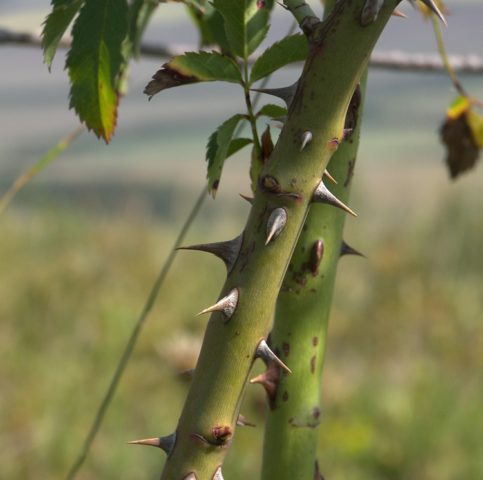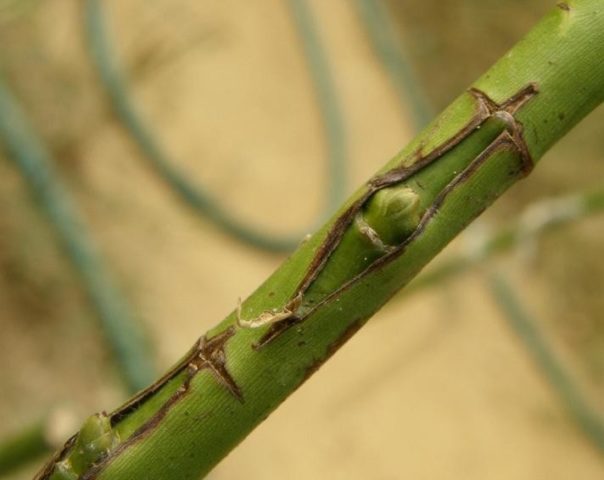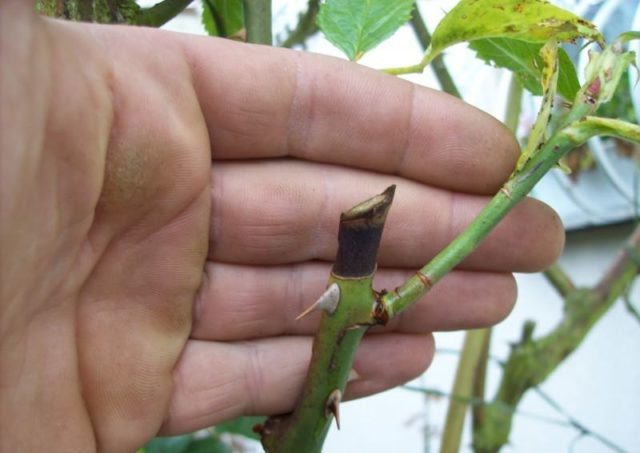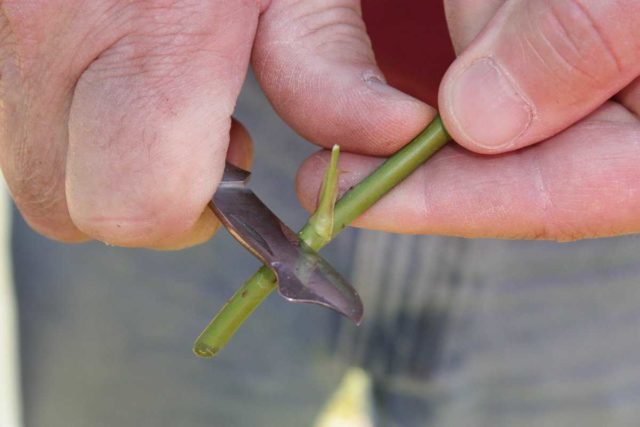Content
- 1 Why roses are grafted into rose hips
- 2 When can you get vaccinated?
- 3 What rose hips are roses grafted on?
- 4 Vaccination options
- 5 How to properly plant a rose on a rosehip - step by step instructions
- 6 Planting and caring for grafted roses on rose hips
- 7 Frequent mistakes and recommendations
- 8 Conclusion
Grafting a rose on a rose hip in the spring is one of the main ways to reproduce a flower. This method allows you to get a new copy of an ornamental plant without seeds and seedlings. The method is characterized by both advantages and disadvantages. To eliminate common mistakes in the implementation of the procedure, you must follow the instructions.
Why roses are grafted into rose hips
The main reason is that both plants belong to the same family - Pink. Rosehips and roses share many characteristics and tolerate crossing, grafting and other breeding procedures well.
Common to the two plants are:
- exactingness to the composition of the soil, lighting;
- temperature regime of growing;
- the structure of the bushes.
Rosehip is considered a less whimsical plant and better adapted to adverse conditions. Grafting to such a bush allows you to get a full-fledged rose. The plant grown on rose hips is characterized by increased resistance to disease, cold, less demanding on growing conditions.

Grafted plants bloom earlier than usual
Due to budding on the rose hips, the development of the rose is accelerated. This is because the bush has a deep root system that provides more nutrients for growth.
When can you get vaccinated?
Spring is considered the best method of budding. During this period, young shoots appear on the bushes, which tolerate the grafting of a rose on a rosehip bole well.
You can carry out the procedure in the summer. At this time of the year, in the shoots of shrubs, an active movement of juices occurs. It promotes the engraftment of cuttings on the rootstock. Summer vaccination is carried out at the end of July or in August.
In the fall, budding is usually not carried out. During this period, the plant prepares for winter and does not have time to take root on the stock. Grafting of cuttings in mid or late February is allowed. This option is considered the most time consuming and complex.
What rose hips are roses grafted on?
The plant used as a rootstock must be strong and healthy. It is advisable that a rosehip grown from seeds or by dividing a bush is used for grafting. Specimens obtained by cuttings are considered less resistant to adverse factors.

The bush must be at least 3 years old
Another important requirement is the absence of damaged shoots or external defects. The bark on the rose hips should be smooth and not damaged. Lignified or dried branches should be removed from the bushes at least several weeks before the procedure.
Preparation of rose hips for the procedure:
Vaccination options
There are several ways to use rose hips as a scion. A suitable option is carried out taking into account the varietal characteristics of the plant being grafted and the conditions of the region.
Budding roses on rose hips
A kidney is used as a scion, which is also called an eye. It is taken from the mother plant or from a pre-cut cutting. A bud inoculation is carried out in the area of the root collar or above, on the shoots.Usually, the budded eye begins to grow in the spring of the following year, when the rosehip, which acts as a rootstock, enters the active growing season.
This vaccination method is the most common. If done correctly, the method allows you to grow a new flowering bush in a few years.
Copulation of a rose on a rosehip
The method involves grafting cuttings. Mandatory requirement - rootstock and scion shoots must be of the same diameter.

The thickness of the stems of the rose hips must be at least 7 mm
Cuttings are harvested as a scion. Each requires 2-3 mature buds. They should not be active during the cutoff period. Cuttings with sprouting buds are not used for grafting.
Grafting a rose for the bark
A common method that is used mainly in the summer. To inoculate a rose on a rose hip, use a pre-prepared stalk with buds.
For the rootstock, you need to choose a shoot on which the bark is easily separated from the wood. A cutting with an oblique longitudinal cut is placed under it. It should go 3-4 cm under the bark.
How to properly plant a rose on a rosehip - step by step instructions
Different vaccinations are used for each season. For the procedure to be successful, you should read the detailed instructions.
How to plant a rose on a rose hip in spring
The procedure is carried out at the end of March or in April. The exact dates are determined taking into account the climatic characteristics of the region. Constant air temperature should not drop to negative values.
In the spring, vaccinations are most often carried out by the copulation method:
- Make an oblique cut on the prepared cutting.
- Soak it in a growth promoter.
- Make a cut of the same length on the rosehip shoot.
- Connect the stem to the stock so that they touch tightly.
- Tie the vaccination site with rubber thread, plastic tape or lime bark.
- Coat the area of contact of the shoots with garden varnish.

The cuts on the rootstock and scion must be smooth, without chipping.
Another option for copulation is grafting into a wedge-shaped cutout. It is made on a rosehip shoot if the thickness of the scion is much greater than the diameter of the cutting. It is wedged to fit inside the cutout.
How to plant a rose on a rose hip in the summer
The above method is well suited for this purpose. To graft a rose on a rose hip in the summer, you can cut off shoots with ripe buds with a cuttings. The procedure is carried out in mid or late August.
During the same period, you can use the budding method:
- Cuttings are harvested with a mature, well-developed bud.
- It is separated from the shoot along with a small piece of bark and wood (up to 3 cm).
- The rosehip bush is dug in to expose the root collar.
- A T-shaped incision is made in the bark of the rootstock bush.
- The bark is carefully pulled back and the prepared kidney is placed under it.
- The vaccination site is covered with a layer of loose soil and moistened.
- The bud is dug out after 2-3 weeks, a small shoot should appear on it, from which a new bush will grow.

The peephole must remain outside the cut
It is also possible to make budding roses on rose hips on superficial shoots in the summer. However, the fixation of the bud on the root collar of the bush promotes better adaptation of the scion. In addition, such a plant is much easier to separate in the future. It grows well with the root system and it is enough to cut an adult bush into several parts to get new specimens.
How to plant a rose on a rose hip in the fall
At this time of the year, copulation or grafting with cuttings is not carried out. You can get vaccinated only at the beginning or in the middle of September. During this period, the movement of juices in the shoots of the dog rose does not stop yet.
For reproduction, methods of budding and fixing the cutting are used. Experienced gardeners perform bark grafting.
Stages of the procedure:
- On a rose hip, a shoot with a diameter of 1 cm or more is chosen.
- The upper part is cut off.
- A sharp instrument is driven under the bark and gently stretched, creating a free space.
- A stalk with a long oblique cut is placed in the resulting recess.
The vaccination site must be coated with garden varnish and wrapped with foil. If the procedure is successful, the cutting will remain fresh after 2-3 weeks. Active growth of the shoot will be already next spring.
Grafting a rose on a rose hip in winter
In late autumn, as well as in December and January, the propagation of plants grown in the open field is not carried out. Grafting roses on the roots of rose hips in winter is allowed only in February, provided that the soil is not too frozen.
The procedure is carried out by the method of budding. Previously, the rose hip bush is torn apart, exposing the root collar. An incision is made into which the kidney is inserted with a piece of bark.
Many gardeners find it difficult to perform this procedure. Due to the low temperature, the bark on the scion is very tough and it is difficult to make the desired cut in it. One of the secrets of winter grafting of roses on rose hips is that breaking the root collar on it, you need to put a rag soaked in warm water. Then the temperature of the bark will rise and it can be easily cut and separated from the wood.
After grafting, the root collar is spud with loose soil. It is strictly forbidden to leave the graft in the open air, as it will freeze. To protect the kidney, you can wrap the incision site with foil.
Planting and caring for grafted roses on rose hips
Plants grown on rootstock are recommended to be planted in the ground in autumn. Spring planting is also allowed, which is carried out from late April to mid-May.
The grafted roses are planted in a new place using standard technology. First of all, a hole is prepared with a depth of 60-70 cm. The drainage layer and soil mixture are poured into it. The plant is placed in the ground with a depth of 5-8 cm.
Roses grafted on rose hips need abundant watering. They are also regularly hilled to stimulate root formation. As the soil compresses, loosening is required. Mulching is necessary in case of long-term absence of atmospheric precipitation. Tree bark or peat is added to the soil, which retain moisture, and as it decomposes, supply the plant roots with nutrients.
To form a bush and stimulate the growth of shoots, pinching is carried out. The upper part of the stems is shortened by 2-3 buds. Due to this, the growth of lateral branches is accelerated, which further ensures abundant flowering.
For the winter, the plant should be pruned. The shrub is covered with a non-woven material, and the roots are spud to protect it from freezing.
Frequent mistakes and recommendations
Grafting is considered the most difficult way to reproduce roses. It is not suitable for all varieties.

Harvesting cuttings can harm the uterine bushes and provoke wilting
The main mistake that gardeners make is the wrong choice of stock. Rosehip seedlings 3-4 years old are used for inoculation. The root collar of the bush should be 7 mm thick and no wider than 12 mm.
For grafting, rose hips must be grown from seeds. Wild specimens are not used.
In the video, how to eliminate mistakes and plant roses on a rosehip correctly:
The wrong choice and preparation of the rose is also the reason why the grafting fails. Inexperienced gardeners cut the cuttings prematurely when the buds are not yet ripe. Such a scion does not take root in the rosehip and dies very quickly. Cutting cuttings with immature buds is allowed only on condition that they root them and use them for grafting in late winter or spring.
For many gardeners, roses do not grow on rose hips due to the fact that the cuts were made inaccurately. They should be smooth, even, free from jaggies. Then the shoots will be in close contact, which will ensure normal fusion.

For vaccinations, it is recommended to use sharp budding or garden knives.
It is not recommended to place rose buds in places where thorns were previously located.The graft does not grow well with this place due to the fact that the wood is denser there, and the movement of juices is limited.
Conclusion
Grafting a rose on a rosehip in spring is a breeding method that requires a competent approach and strict adherence to instructions. This procedure is considered laborious and does not always end successfully. Rose grafting is also advisable in the summer. The procedure can be carried out in several ways, which allows you to choose the most convenient for a particular plant.








